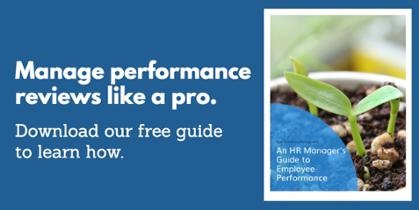
Though you probably offer a combination of constructive feedback and coaching to employees, there may still be instances when performance falls below expectations and requires formal follow-up. To help employees make desired improvements, a performance improvement plan (PIP) is a useful tool for communicating performance concerns and showing employees what they can do to address them.
When there is a performance problem, clarity is key. By learning how to write a performance improvement plan and communicate it effectively, you create greater clarity about next steps and provide a roadmap for improvement.
Benefits of a Performance Improvement Plan
One key aspect of a performance improvement plan is the written summary of employee behaviors that stand in the way of job success. The other is a plan for what an employee needs to do to address the performance issue. Unlike verbal or other informal warnings, the PIP describes required follow-up actions in detail.
When you learn how to write a performance improvement plan that lays out the problem and provides a clear path, you increase the chances of realizing the following benefits:
- Increased accountability: By describing the actions employees must take to improve performance, PIPs put them in a position to take more accountability for performance outcomes.
- Clearer performance messaging: Employees can sometimes misinterpret on-the-spot coaching and other verbal feedback. A written PIP spells out the performance issue and how to fix it.
- Better risk management: A PIP demonstrates the actions you are taking to help an employee improve. In the unfortunate event that improvement doesn’t occur, having a PIP can help you manage the potential risk of litigation if you need to dismiss an employee.
How to Write a Performance Improvement Plan
Although a PIP doesn’t deliver what most would describe as positive feedback, an employee may be more open to the “negative” and constructive feedback in a PIP than you might think. In fact, a Zenger Folkman study found that 92 percent of surveyed employees agreed with the statement: “Negative feedback, if delivered appropriately, is effective at improving performance.”
To write a PIP in a way that is most effective at improving employee performance, take the following actions:
Know the right circumstances for a performance improvement plan.
Before you start writing a PIP, you need to know when it is appropriate to use and when it may be premature or too late. For example, an employee only a few weeks into a new role who is still learning (and possibly making mistakes) needs more time to settle in before you consider a performance improvement plan. Similarly, an employee who has committed a gross violation of your policy may need to face immediate dismissal rather than a PIP.
Some of the situations in which a PIP may make sense include:
- When the employee has already received constructive feedback or a poor performance review and has not made the desired improvements.
- When coworkers or customers have submitted complaints about the employee.
- When the employee has consistently struggled in a particular area.
- When the employee made one or more egregious errors that negatively impacted business operations.
Describe the problem and the desired goal.
A PIP will be far less meaningful if you merely state the problem. You also need to describe the characteristics of acceptable performance.
A performance improvement plan should explain the desired performance and where the employee’s current performance falls short. Therefore, to reduce ambiguity, you will need to provide relevant examples. Examples of desired performance goals could include improved productivity, better work quality, and smoother communication with coworkers.
Lay out required employee actions and clear metrics for success.
For a PIP to have your desired impact, you’ll need to explain the exact actions an employee must take to reach the desired goal. Simply expressing a need for performance to improve to “good” or “acceptable” levels can be highly subjective and debatable.
When possible, clearly state the metrics you will use to measure changes in employee performance following the PIP. Depending on the employee’s role, you could use the following metrics:
- A target number of sales.
- A specific change in customer service ratings.
- A reduction in the employee’s error rate when performing specific tasks.
Detail the available organizational support.
In some cases, an employee’s performance challenges may be the result of particular issues, such as the need for a disability accommodation under the Americans with Disabilities Act (ADA) or for specific technology or equipment. Therefore, be sure to include language in the PIP that explains what organizational support is available to the employee and the steps they may need to take to request additional support.
Explain milestones for follow-up.
Writing and delivering a performance improvement plan is not a one-off event—it requires regular follow-up. In addition to gauging an employee’s improvement over time, periodic check-ins also provide an opportunity for employees to ask questions, receive clarification, and request additional coaching.
To ensure the PIP remains relevant after discussion with the employee, include a written plan and timetable for check-ins so the employee knows the schedule for improvements. A key part of your check-in calendar should also be a deadline by which you expect the employee to reach the desired goal stated in the PIP.
Describe the consequences of continued issues.
Although you want to clarify that the performance improvement plan is not intended to lead to dismissal, you need to be prepared for that possibility. Therefore, make it clear what could happen if the employee cannot reach the intended performance goal by the deadline you set.
Communicate the consequences of continued performance issues, which might include the following:
- Loss of eligibility for specific job-related incentives (e.g., bonuses and perks)
- Demotion
- Termination of employment
Write Performance Improvement Plans That Deliver Results
When you know how to write a performance improvement plan, it can be valuable in helping employees reach their full potential. By investing time in explaining the actions employees need to take to improve performance, you can help them boost productivity and remove the obstacles standing in the way of their growth and advancement.
To pull together the information you need to write a thorough PIP, you need access to past performance metrics that detail progress toward improvement. Instead of scrambling for outdated or inaccurate employee data from multiple systems, you can get consistent and up-to-date information from a single integrated workforce management platform. To learn more, read our guide, The Hidden Costs of Managing Employees in Disconnected Systems.
Originally published Mar 31, 2016, updated August 26, 2021.


